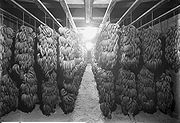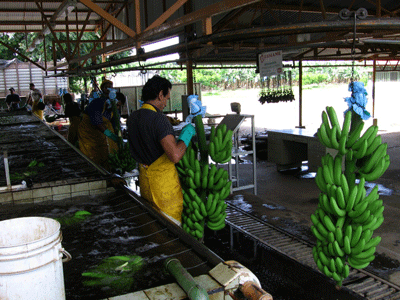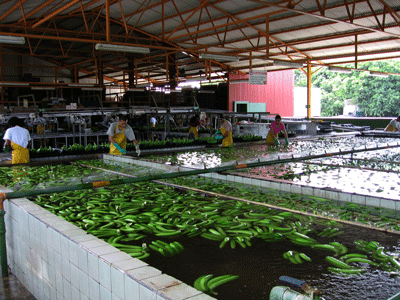Introduction
Breakfast, is one of the highly-rated meals among the human consumption rituals, although many go without it. Different people take different kinds of foods (bread, doughnuts), fruits (bananas, oranges) and drinks (tea, fruit juices, coffee) for their breakfast depending on; availability, weather conditions, taboo and mostly their financial status. This research project is going to critically focus on Bananas which to the best of knowledge is one of the most common and readily available breakfast meals.
Banana is the commonly used name for the fruit and the plant, and is largely grown in the tropical lands. Bananas are believed to have been “domesticated in Papua New Guinea and today are cultivated throughout the tropics” (Hernandez & Witter 173). Banana plants are widely grown for their fruit and to a lesser extent for fiber production used for making ropes and mats. The banana plant is tall and fairly sturdy and can grow up to a “height of up to 8 meters with leaves of up to 3 meters” (Acrobat). The banana fruit has an outer cover known as the peel which protects the edible inner part rich in vitamin B6, vitamin C and potassium. The plant can produce a bunch of green, yellow and red banana fruits before dying. After a mature plant is cut another plant sprouts to replace it.
Bananas are normally eaten while raw or cooked, depending on the various cultures: for the western cultures What is eaten is the inner part and the peel is thrown away, while among the Asians, both the peel and the inner part are cooked and eaten together (Acrobat). Apart from being eaten as fruit, they are sometimes dried, cut and eaten as chips or ground into banana flour. The diagram below shows an appealing photo of some ripe banana fruits in a retail shop.

Bananas are grown, processed and consumed in different parts of the world depending on climatic conditions.
Bananas are grown in more than 107 countries across the world: in plantations (groups of cultivators), small scale or even by individuals. Bananas are major staple food in many developing nations and are widely grown in Asian and South America continents. Countries which grow bananas are; India, China, Indonesia and Thailand in Asia, South American countries which grow bananas include; Brazil (highest producer), Ecuador, Costa Rica, Colombia and Mexico. In Africa bananas are grown in; Uganda, Rwanda, Cameroon, Madagascar, Nigeria and Burundi with Uganda being the highest producer in Africa. “Brazil and Ecuador produces more than two-thirds of world’s banana crop (about 25 million tones)” (Mario). The United States of America and European countries such as Germany and Britain are the largest importers of banana fruits.
Banana in Brazil
Brazil is the fourth largest banana producer in the world after Ecuador, India and Uganda. Brazil is the largest country in South America and is bordered by Argentina, Peru, Uruguay, Colombia and Venezuela. Its terrain consists of numerous mountain ranges such as Serra do Mar and Serra do Espinhaco, averaging 2,000 meters in height and is found in the south-central parts of the nation. There are also high mountains to the north that boarder Venezuela while central Brazil consists of plateau and highlands. The plateau is even with some heights of up to 100 meters above sea level. The rest of the country is made up of river basins. Brazil is blessed with numerous rivers and river basins that are favorable for agricultural production: the Amazon River, the second largest river in the world after Nile cuts across Brazil.
Brazil has extensive tropical soils which produce million tonnes of grains (Mario). The fertility levels of these tropical soils are low but due to their extensiveness a lot of produce is produced from them. When the land is virgin, the soils are fertile but, due to increased soil acidity as farming goes on, their fertility level declines. Areas near Sao Paul have fertile soils known as “terra roxa (red earth)” (Acrobat). Soils to north are fertile but lack water unless irrigated. The least fertile soils are found in areas covered by the rainforest where the soils are always saturated.
Brazil is found within the tropics but its climate varies from one region to another. It has five climatic regions namely equatorial, tropical, semiarid, subtropical, and highlands. Much of Brazil receives moderate rainfall a year with much of it in summer. The northeast is the driest and hottest part in the country with scarce rainfall and is associated with severe droughts.
Brazil has more than five thousand hectares of planted banana plants and about six million tones of bananas are produced annually. The country’s population consumes much of the banana produced and small percentage of total output is exported. More than 500 varieties banana plants are grown in different regions depending on tolerance of each variety to those climatic conditions. To the north of Brazil, there are small plantations of bananas with many of these plantations being subsistence and with annual output of more than one million tons of banana fruits. In the region (north of Brazil) numerous banana varieties are grown. The area is prone to black Sigatoka disease that attacks banana plants. As a precaution farmers grows hybrid varieties resistance to the disease. In north east of the country production is done in small plantation in irrigated farms because the area is dry. The area is also dominated by varieties of banana species with more than 180,000 hectares of land under banana plantation. Another more than 140,000 hectares of land to southeast is covered with banana plants of various varieties. The Sao Paulo state is the largest producer of bananas in Brazil and Cavendish subgroup of banana species is predominant here. Irrigation in banana farming is also practiced to the north of Mina’s state.
In central west Brazil only 27,000 hectares of land is under banana cultivation with an annual output of less than half a million tones of banana fruits. In the above regions that is, north, northeast, central and south, plantations are owned by individuals and companies. Laborers to these plantations are hired: most of these workers are immigrants from neighboring countries. In central west, production is done by group of people known as meeiros. These people are given farm lands to grow bananas but at the end they share half of the produce with the owners of the farms. In the state of Santa Catarina bananas are grown in average by small scale farmers who use family members as workforce. The northeast region tops in Brazilian banana production followed by south-east then, north, south and center-west.
Banana plants in Brazil are highly affected by pests and diseases. As a result researchers have been forced to develop genetically modified varieties that are pest resistance. “Bananas are commonly affected by black Sigatoka Fungus” (Mario). Farmers apply varieties of Anti-fungus agrochemicals on their plant to kill pest. On the other hand scientists are busy doing modification on bananas species to develop pest resistance species as government work to control the spread of pest. “Panama disease and yellow Sigatoka diseases have been the main enemies for the banana plant over years in Brazil” (Mario). Farmers have been fighting these diseases by use of fungicides.
In 2003, another disease known as black Sigatoka entered Brazil and is said to be threatening the large plantations of banana in central-south. This disease spreads very fast to extend of pushing the yellow Sigatoka out. To ensure that black Sigatoka does not cause big threat, farmers have in place many banana crop varieties which are resistant to diseases. Fertilizers are used in infertile soils: for new plants, ammonium sulfate is applied with the quantity used increasing as the plant grows. Until the beginning of twentieth century banana plantations in Brazil were owned by foreign multinational companies. In mid 20th century plantation changed hands to local farmers who grow and sell to the companies.
The climatic conditions and the domestic market in Brazil favor production of bananas. “Bananas were introduction in Brazil from Africa in sixteenth century by the Portuguese and Spanish explorers” (Hernandez & Witter 175). Bananas were first discovered in south Asia 200 A.D, and then moved to Africa through the spread of Islam. Portuguese explorers who sailed through the coast of West Africa carried with them the fruit into South America. Apart from history of the crop in Brazil and the climatic condition, the domestic market for the fruit favors large scale production. Banana is a tropical plant and does well in areas with tropical climate. Bananas flourish in areas which are hot and humid and that the reason why they are widely grown in tropics. Cold weather kills the plant while strong wind blows the plant. Banana does well in varieties of soil kinds as long as these soils are deep and have good drainage: Saturated soils can not hold the plant. Strong winds and cold weather cause great havoc on the crop.
As stated earlier Brazil has five different climatic regions raging from equatorial, highlands, semi-arid, tropic to sub-tropic, it offers a favorable conditions for growth of bananas. Bananas in Brazil are grown in all regions except the equatorial regions. In regions experiencing equatorial climate, soils are always saturated and weather is too cold discouraging banana growth. Brazil has tropical soils which are best for banana production. In the arid and semi-arid areas where rain is scare irrigation is practiced.
Due to various factors much of banana in produced in Brazil is consumed domestically. “Brazilians are believed to consume banana more than any other fruit” (Acrobat), hence provide large market for the fruit. Secondly, the bananas produced are of low quality and the population does not have problem with consuming them. Lastly, the cost of production is high resulting to high export prices which discourages importers. Brazil exports less than one per cent of her total banana production and her main importers are Argentina, Uruguay and parts of Europe.
Other than being grown for consumption and exports, banana plants have got other uses in Brazil: a banana variety known as Manila hemp does not produce edible fruits but farmers grows it for their strong fiber used for making ropes, blankets and mats, some people believe that banana peels can clean and polish shoes and banana peels are used as manure because they contain potassium a key element in crop production. Banana production is source of income to farmer and earns the country millions of U.S dollars through export. The sector creates thousands of jobs both skilled and unskilled from the farms to processing plant and finally marketers.
Banana processing is done in processing plant located near plantation from where it’s exported after packaging. Bananas are perishable and to extend fragile hence require fast and careful handling to preserve their quality. Bananas are harvested at different level depending on whether are to be exported or too used domestically. If they are for export they are harvested when still green so that they could get ripe on the way. After green bananas have matured, the bunch of green bananas is cut and transported to processing plants for processing. These processing plants are either simple or complex and are located near the farms. In harvesting bananas, farmers go to farms with machetes and cut the stem containing bunch of bananas. The bunch is then loaded into tracks which transport them into processing plants.
If bananas are to be consumed domestically, they are treated in way that they will ripen quickly. One method of ripening bananas is; on arrival the stem of the bunch is hung in cool and sunlight free place to ripen to good eating quality. It will take some day before it is ready for consumption. This method is used by farmers with large plantations. The practice is as shown by the figure below,

Other than hanging the bunch of bananas, the bunch is raped in a polythene bag and sliced apple is added inside to speed ripening of bananas. This is a traditional method commonly used by the small scale farmers. Once bananas are ripe, they are distributed to retail markets for sale or other could still be stored under refrigerator at the homes for domestic consumption. Ripe bananas are consumed fresh in salads and pudding while over ripe bananas are use to make ice creams.
Bananas for export are exported while green. The farmers cut bunches of bananas from their farms, then using trucks transports them into the processing plants. The processing plant here are usually “simple made up of open-air structures with roofs” (Essomat). On arrival bunches of bananas are removed from the track and are hung on ropes placed above workers heads. The ropes are attached to pulleys that transports bunch into an area with running water that contains some chemicals. The pulleys are manually operated hence requires a lot of human energy. The chemical solution is made to remove bugs from the bananas. By the side are the workers who cut the fruits from the stem and drop each piece of banana into the solution. The water is continuously flowing hence moves bananas from one point to another. In the next point another “group of workers remove the bad bananas from the lot” (Essomat). After separation, workers remove bananas from the solution and place them on dry surface to dry. The figures below show the processing of bananas in sheds.


The bananas are dried using good “breeze or fans; once completely dry, the bananas are placed in cardboard boxes” (Essomat) which can hold several bananas. After all bananas have been boxed they are moved to distribution points for export. Others may be shipped to other elaborate plants for further processing. Banana from the southern state of Santa Catarina and northeast state are mainly for export. The northeast exports to Europe while the southern state export to Argentina and Uruguay markets.
Banana marketing and advertisement is done through media or diplomatic negotiations and plantation owning companies. The identification of consumers’ needs and desires are reasons for marketing. Marketing is aimed at getting the right customer for the bananas. Bananas are nearly consumed by every group in the society from the babies to the old hence, marketing in Brazil focuses on all age groups. Many use bananas as pudding after their meals or banana cream pie, banana sauce and banana chips. Bananas are the staple food for babies in most developing world. Companies which own the banana plantations do market, and export their produce. For example, the Del Monte Company in northeast state supplies banana to Europe.
Base map for banana from site of production through distribution channels to ones breakfast table:

Works cited
Acrobat, banana in Brazil. 2008. Web.
Essomat, Banana plant: processing from tree to box. 2008. Web.
Hernandez, C. E. and S. G. Witter. Evaluating and managing the environmental impact of banana productions in Costa Rica: A systems approach. Ambio 1996: 171-178.
Mario Osava, the banana wars against fungus. 2008. Web.
The Manitoba Museum. Has the world gone bananas. 2008. Web.